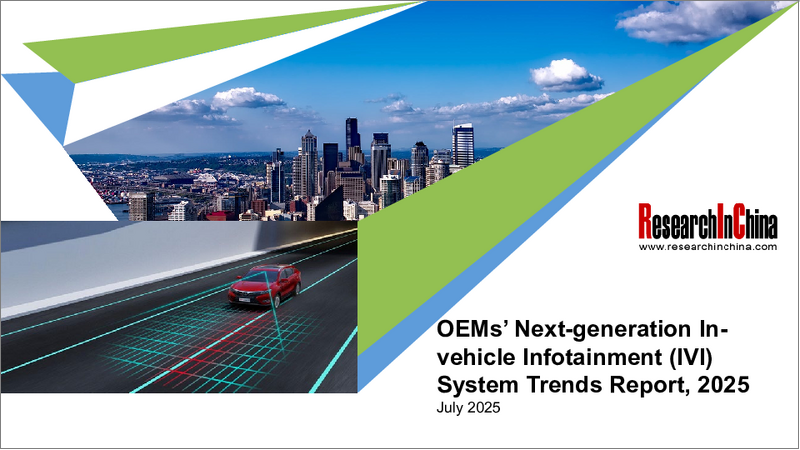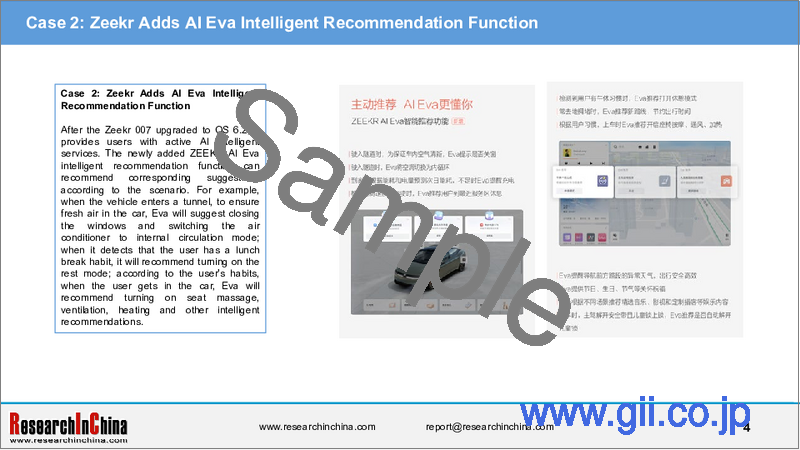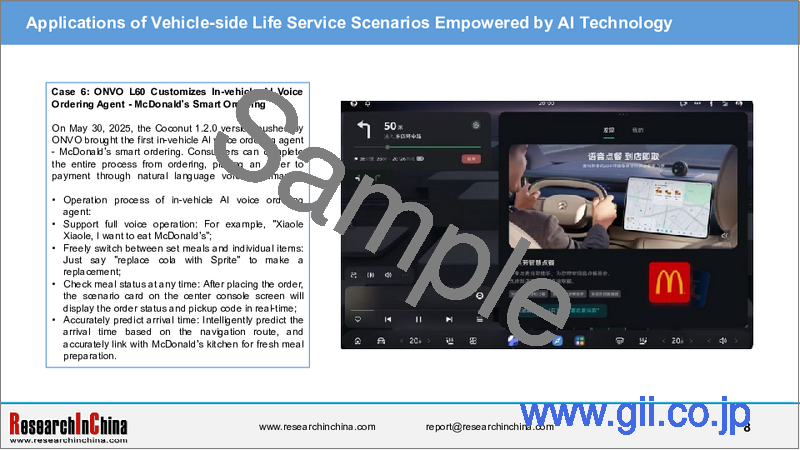|
|
市場調査レポート
商品コード
1777125
OEMの次世代車内インフォテインメント(IVI)システムの動向(2025年)OEMs' Next-generation In-vehicle Infotainment (IVI) System Trends Report, 2025 |
||||||
|
|||||||
| OEMの次世代車内インフォテインメント(IVI)システムの動向(2025年) |
|
出版日: 2025年07月30日
発行: ResearchInChina
ページ情報: 英文 295 Pages
納期: 即日から翌営業日
|
全表示
- 概要
- 目次
ChatGPTが2023年にAI大規模モデルの世界的な波を巻き起こして以来、自動車産業はインテリジェント化を加速させています。主流自動車メーカーは率先して、マルチモーダル大規模モデルを車内インフォテインメントシステムに深く組み込み、ユーザーの運転習慣、選好、シナリオニーズを分析することで、パーソナライズされたコックピットエコシステムを構築しています。アルゴリズムとハードウェアの最適化により、大規模モデルの学習・推論コストは大幅に削減されています。公開データによると、2025年上半期において、国内の主流大規模モデルのAPI呼び出しコストのほとんどが減少傾向を示しています。
コスト削減の推進の恩恵を受け、AI技術の普及の波は車両側シナリオへの浸透を加速させ、「第3の生活空間」のインテリジェント境界を再定義しています。
当レポートでは、中国の自動車産業について調査分析し、主要自動車メーカーのインフォテインメントシステムに関する反復的な開発背景、最新世代のインフォテインメントシステムの特徴、車内インフォテインメントシステムの40件を超える実用化事例などの情報を提供しています。
目次
序文
第1章 車内インフォテインメント(IVI)システムの概要
- 車内インフォテインメントシステムの定義と調査範囲
- 中国の乗用車向けインテリジェントIVIシステムの搭載数
- 独立系ブランドの乗用車向けインテリジェントIVIシステムの搭載数
- 合弁企業の乗用車向けインテリジェントIVIシステムの搭載数
第2章 OEMの次世代IVIシステム
- BYD
- Geely Group
- Changan
- Great Wall Motor
- GAC
- FAW Hongqi
- Chery
- SAIC
- Dongfeng Voyah
- BMW
- Mercedes-Benz
- NIO
- XPeng Motor
- Li Auto
- Leapmotor
- Xiaomi Auto
- Harmony Intelligent Mobility Alliance (HIMA)
第3章 自動車エコシステムコンテンツ:ソーシャル化の動向
- 過去1年間のIVIソーシャル機能OTA
- 動向1(1):カメラ機能を搭載したモデルが増え、ドライバーと乗客がいつでも旅の状況を記録できるようになった
- 動向1(2)
- 動向2
- 動向3
- 動向4
第4章 自動車エコシステムコンテンツ:ポジショニングとナビゲーションの動向
- 過去1年間のIVIナビゲーション機能OTA
- 自動車用ナビゲーションOTAアップグレードの5つの主な方向性
- 動向1:AI+ARナビゲーション技術、自動車用ナビゲーションは「ウェアラブル」時代へ
- 自動車ナビゲーションの動向2(1)
- 自動車ナビゲーションの動向2(2)
- 自動車ナビゲーションの動向2(3)
第5章 自動車エコシステムコンテンツ:オーディオ/ビデオの動向
- 過去1年間のIVIオーディオ/ビデオアプリOTA
- 自動車オーディオ・ビデオの動向1(1):コックピット内のマイク不要のカラオケで、いつでもどこでも歌える
- 自動車オーディオ・ビデオの動向1(2):AI技術がマイクレスカラオケをサポート、AI歌唱伴奏・AI聴取伴奏・AIチューニングなどを実現
- 自動車オーディオ・ビデオの動向2
- 自動車オーディオ・ビデオの動向3
第6章 自動車エコシステムコンテンツ:ゲームの動向
- 過去1年間のIVIゲームアプリOTA
- ゲームのインストール方法(1)
- ゲームのインストール方法(2)
- 自動車ゲーミングの動向1
- 自動車ゲーミングの動向2:OEM各社がユーザーに専用のゲーム空間を提供するためにeスポーツコックピットを発売
第7章 自動車HMIの動向
- 過去1年間の自動車HMI OTA(1):音声
- 過去1年間の自動車HMI OTA(2):生体認証
- 過去1年間の自動車HMI OTA(3):視覚/嗅覚
- 動向1
- 動向2:生体認証技術が車内決済機能をさらに拡大
- 動向3
- 動向4
第8章 自動車シナリオモードの動向
- 過去1年間の自動車シナリオモードOTA
- 自動車シナリオモードの動向1:「クイックコマンド」機能、ワンクリック/ワンセンテンスでシナリオに直接アクセス
- 自動車シナリオモードの動向2(1)
- 自動車シナリオモードの動向2(2)
第9章 その他の動向
- 動向1:車内アプリケーションモールはクラウド上にあり、ローカルストレージと演算能力を占有しない
- 動向2
- 動向3
- 動向4
ResearchInChina releases the "OEMs' Next-generation In-vehicle Infotainment (IVI) System Trends Report, 2025", which sorts out iterative development context of mainstream automakers in terms of infotainment systems, characteristics of the latest generation of infotainment systems, and deeply analyzes development trends of in-vehicle infotainment from multiple dimensions such as ecological content, human-machine interaction, and scenario modes, and summarizes more than 40 practical application cases of in-vehicle infotainment systems in detail.
Since ChatGPT set off a global wave of AI large models in 2023, the automotive industry has accelerated its intelligent transformation. Leading automakers have taken the lead in deeply embedding multimodal large models into in-vehicle infotainment systems, and building personalized cockpit ecosystems by analyzing users' driving habits, preferences and scenario needs. With the optimization of algorithms and hardware, training and inference costs of large models have been significantly reduced. Public data shows that in 2025H1, the API call costs of most domestic mainstream large models showed a downward trend.
Benefiting from the promotion of cost reduction, the wave of AI technology popularization is accelerating its penetration into vehicle-side scenarios, redefining the intelligent boundary of the "third living space". According to the "OEMs' Next-generation In-vehicle Infotainment (IVI) System Trends Report, 2025", 7 typical application cases of in-vehicle infotainment systems are listed below.
In-vehicle Human-machine Interaction Scenarios Empowered by AI Technology
Case 1: Voyah Courage Introduces DeepSeek, Making the Cockpit an "AI Agent"
Voyah Courage's "Xiaoyao Cockpit" has achieved diversified AI functions such as AI multi-semantic command recognition, AI poetry creation, AI painting, AI couplet matching, AI chat, and AI real-time information retrieval through in-depth integration with DeepSeek, making the Voyah Courage cockpit officially an "AI agent".
AI poetry creation: When users get inspired during the journey, they only need to give some simple theme prompts, such as "scenery during a spring road trip", and AI can quickly create a beautiful poem.
AI couplet matching: On traditional festivals or special occasions, users can play couplet games with the AI agent. When users come up with an upper couplet, the AI agent can quickly come up with a neat and creative lower couplet, which not only tests the AI's language ability but also creates a joyful cultural interaction atmosphere in the car.
AI real-time information retrieval: The AI agent in Voyah Xiaoyao Cockpit, through real-time connection to the network and DeepSeek's powerful information retrieval and analysis capabilities, can quickly and accurately provide users with required information (such as road conditions, weather, surrounding service facilities, etc.).
Case 2: Zeekr Adds AI Eva Intelligent Recommendation Function
After the Zeekr 007 upgraded to OS 6.2, it provides users with active AI intelligent services. The newly added ZEEKR AI Eva intelligent recommendation function can recommend corresponding suggestions according to the scenario. For example, when the vehicle enters a tunnel, to ensure fresh air in the car, Eva will suggest closing the windows and switching the air conditioner to internal circulation mode; when it detects that the user has a lunch break habit, it will recommend turning on the rest mode; according to the user's habits, when the user gets in the car, Eva will recommend turning on seat massage, ventilation, heating and other intelligent recommendations.
Case 3: Hongqi Lingxi Cockpit Integrates Deeply with DeepSeek to Enhance Voice Interaction Experience
The Lingxi Cockpit of Hongqi Tiangong 05 is deeply integrated with the DeepSeek-R1 model. Its intelligent voice system has four sound zone voice recognition functions, supports voiceprint reproduction, "see and speak" interaction mode, and improves context understanding ability. It also supports dialect interaction such as Sichuan dialect and Cantonese, enabling smooth and natural anthropomorphic dialogue. In addition, the in-vehicle intelligent system can not only record basic setting data such as seat angle and temperature preference but also push personalized music playlists based on user usage data and preference analysis.
Applications of In-vehicle Entertainment Scenarios Empowered by AI Technology
Case 4: NIO Introduces Mic-free KTV 2.0, Upgrading KTV Experience with AI Technology
After NIO's Banyan 3.0.0 system OTA, it launched the AI technology-powered Mic-free KTV 2.0. This version adds AI intelligent accompaniment, AI intelligent sound effects, and AI voice filters.
AI intelligent accompaniment: Supports enabling accompaniment and intelligent accompaniment modes in music software such as QQ Music and NetEase Cloud Music. When the intelligent accompaniment mode is turned on, the system will use algorithms to intelligently detect and automatically switch between original sound and accompaniment according to whether the user is singing.
AI voice filter: NIO's self-developed real-time intelligent mixing algorithm, AI performs real-time intelligent mixing and vocal beautification on the user's singing voice, with functions such as real-time nasal sound removal, dental sound removal, spatial sense enhancement, and volume balance.
AI intelligent sound effects: Supported by NIO's self-developed sound effect algorithm, six personalized sound effects are added, including intelligent sound effects that can be adaptively adjusted according to human voice and accompaniment, original sound close to the user's real voice, immersive space with echo effect, super reverb with full reverb, KTV sound effect, and cute Minions sound effect.
Case 5: Great Wall Motors Launches "AI Listening Companion" Function, Introducing an Exclusive "Emotional DJ"
On November 8, 2024, Tencent Music Entertainment Group (TME) and Great Wall Motors launched the "AI Listening Companion" function. This function comprehensively considers various scenario information such as location, weather, time, and user's emotional state, and combines TME's virtual "personal DJ" to achieve accurate conversational song recommendations. For example, in the evening when driving in the mountains, if the car owner is in a relaxed mood, the system may recommend a soothing folk song.
In addition to recommending music, the virtual "personal DJ" can also conduct personalized transitions and song introductions, creating a warm and interesting music sharing atmosphere.
Applications of Vehicle-side Life Service Scenarios Empowered by AI Technology
Case 6: ONVO L60 Customizes In-vehicle AI Voice Ordering Agent - McDonald's Smart Ordering
On May 30, 2025, the Coconut 1.2.0 version pushed by ONVO brought the first in-vehicle AI voice ordering agent - McDonald's smart ordering. Consumers can complete the entire process from ordering, placing an order to payment through natural language voice commands.
Operation process of in-vehicle AI voice ordering agent:
Support full voice operation: For example, "Xiaole Xiaole, I want to eat McDonald's";
Freely switch between set meals and individual items: Just say "replace cola with Sprite" to make a replacement;
Check meal status at any time: After placing the order, the scenario card on the center console screen will display the order status and pickup code in real-time;
Accurately predict arrival time: Intelligently predict the arrival time based on the navigation route, and accurately link with McDonald's kitchen for fresh meal preparation.
Case 7: Lixiang Tongxue Life Assistant Agent Upgraded to Realize Functions such as Food Delivery Ordering and Life Payment
In the OTA7.4 version upgrade of Li Auto in May 31, 2025, the Lixiang Tongxue Life Assistant Agent is linked with the "Alipay In-vehicle Assistant" to call applets and payment functions for ordering, payment, express query and other functions.
Ordering service: Users can directly call catering services in Alipay applets (such as Starbucks, McDonald's, etc.) through voice commands to complete menu selection, order placement and payment, without manual operation throughout the process. For example, users only need to say "Lixiang Tongxue, help me order a Starbucks latte", and the system can automatically jump to the corresponding applet and complete the order. In addition to ordering takeout online, the Lixiang Tongxue Life Assistant agent also supports restaurant reservation/queuing services. For example, when a user voice says "Lixiang Tongxue, I want to eat Haidilao", the Li Auto Student agent can help the user check nearby stores, queue, and even place an order.
Payment service: Supports common payment scenarios such as utility bills and phone recharge. After users confirm payment information through voice, they can directly call Alipay payment function to complete the deduction. For example, "Lixiang Tongxue, help me pay 100 yuan for electricity" can trigger the payment process.
Express query: Connected with Alipay's express service, users can query the logistics status of packages through voice, such as "Lixiang Tongxue, check where my express is", and the system will feedback logistics information in real-time.
Table of Contents
Preface
1 Overview of In-vehicle Infotainment (IVI) System
- 1.1 Definition and Research Scope of In-vehicle Infotainment System
- 1.2 Installation Status of Intelligent IVI System for China's Passenger Cars
- Intelligent IVI System Installations and Installation Rate
- Intelligent IVI System Installations and Installation Rate (By OEM Type)
- Intelligent IVI System Installations and Installation Rate (By Price Range)
- Intelligent IVI System Installations and Proportion (Top 15 Brands)
- Intelligent IVI System Installations and Proportion (Top 15 Models)
- Market Share of Intelligent IVI System (By System)
- 1.3 Installation Status of Intelligent IVI System for Independent Brands' Passenger Cars
- Intelligent IVI System Installations and Installation Rate (By Price Range)
- Intelligent IVI System Installations and Proportion (Top 15 Brands)
- Intelligent IVI System Installations and Proportion (Top 15 Models)
- Market Share of Intelligent IVI System (By System)
- 1.4 Installation Status of Intelligent IVI System for Joint Ventures' Passenger Cars
- Intelligent IVI System Installations and Installation Rate (By Price Range)
- Intelligent IVI System Installations and Proportion (Top 15 Brands)
- Intelligent IVI System Installations and Proportion (Top 15 Models)
- Market Share of Intelligent IVI System (By System)
2 Next-generation IVI Systems of OEMs
- 2.1 BYD
- Iteration of IVI System
- Latest IVI System
- Typical Models with IVI System (1): Fangchengbao Bao 8
- Typical Models with IVI System (2): Denza Z9
- 2.2 Geely Group
- Geely Auto
- Iteration of IVI System of Geely Auto
- Iteration of IVI System of Zeekr
- Geely's Latest IVI System
- Latest IVI System (1)
- Latest IVI System (2)
- Typical Models with IVI System (1): Lynk & Co Z20
- Typical Models with IVI System (2): Geely Galaxy E5
- Zeekr
- Iteration of IVI System
- Latest IVI System
- Typical Models with IVI System: Zeekr MIX
- 2.3 Changan
- Iteration of IVI System
- Latest IVI System
- Typical Models with IVI System: Changan Nevo E07
- Avatr
- Iteration of IVI System
- Typical Models with IVI System: Avatr 07 Pro+
- Avatr Self-developed Next-generation Intelligent Cockpit
- Changan Deepal
- Iteration of IVI System
- Latest IVI System
- Typical Models with IVI System: Deepal S05
- 2.4 Great Wall Motor
- Iteration of IVI System of WEY
- Latest IVI System (1)
- Latest IVI System (2)
- Typical Models with IVI System: 2025 WEY Blue Mountain
- 2.5 GAC
- Iteration of IVI System
- Latest IVI System
- Typical Models with IVI System: Trumpchi Xiangwang S7
- 2.6 FAW Hongqi
- Iteration of IVI System
- Latest IVI System
- Typical Models with IVI System: Hongqi Tiangong 05
- 2.7 Chery
- Iteration of IVI System
- Latest IVI System
- Typical Models with IVI System: Chery Fulwin A8L
- 2.8 SAIC
- Rising Auto
- Iteration of IVI System
- Latest IVI System
- IM Motors
- Iteration of IVI System
- Latest IVI System (1)
- Latest IVI System (2)
- 2.9 Dongfeng Voyah
- Iteration of IVI System
- Latest IVI System
- Typical Models with IVI System: Voyah Courage
- 2.10 BMW
- Iteration of IVI System
- Latest IVI System
- Typical Models with IVI System: New BMW iX3
- 2.11 Mercedes-Benz
- Iteration of IVI System
- MB.OS
- Latest IVI System: Gen4 MBUX IVI System
- 2.12 NIO
- Iteration of IVI System
- Vehicle Global OS
- Latest IVI System (1)
- Latest IVI System (2)
- Latest IVI System of ONVO
- Typical Models with IVI System: NIO ET9
- Typical Models with IVI System: ONVO L60
- 2.13 XPeng Motor
- Iteration of IVI System
- Latest IVI System
- Typical Models with IVI System (1): XPeng G9
- Typical Models with IVI System (2): 2025 XPeng G9
- 2.14 Li Auto
- Iteration of IVI System
- Latest IVI System
- Typical Models with IVI System: 2025 Li MEGA
- 2.15 Leapmotor
- Iteration of IVI System
- Latest IVI System
- Typical Models with IVI System: Leapmotor B10
- 2.16 Xiaomi Auto
- Latest IVI System
- Typical Models with IVI System: Xiaomi SU7 Ultra
- 2.17 Harmony Intelligent Mobility Alliance (HIMA)
- Iteration of IVI System
- Latest IVI System
- HarmonySpace 5 (1): Mobility Space
- HarmonySpace 5 (2): Music Space
- HarmonySpace 5 (3): Film & TV Space
- HarmonySpace 5 (4): Theme Space
- HarmonySpace 5 (4): Harmony Ecosystem Expansion
- Typical Models with IVI System: Stelato S9
- Typical Models with IVI System: Luxeed R7
3 Automotive Ecosystem Content: Socializing Trends
- 3.1 IVI Social Function OTA in The Past Year
- 3.2 Trend 1 (1): More models are equipped with camera functions, allowing drivers and passengers to record the scenariory of the journey at any time
- Case (1)
- Case (2): Zeekr 001 / 001 FR upgrades camera functions and introduces AI image creation function
- Case (3)
- 3.2 Trend 1 (2)
- Case (1)
- 3.3 Trend 2
- Case (1)
- Case (2)
- 3.4 Trend 3
- Case (1)
- Case (2)
- Case (3)
- 3.5 Trend 4
- Case (1)
- Case (2)
4 Automotive Ecosystem Content: Positioning & Navigation Trends
- 4.1 IVI Navigation Function OTA in The Past Year
- 4.2 Five Major Directions for Automotive Navigation OTA Upgrade
- 4.3 Trend 1: AI+AR navigation technology, automotive navigation enters the "wearable" era
- Case (1)
- Case (2): AMAP and Rokid jointly launch NaviAgent application to build a new "AI+AR" navigation ecosystem
- Case (3)
- 4.4 Automotive Navigation Trend 2 (1)
- 4.4 Automotive Navigation Trend 2 (2)
- 4.4 Automotive Navigation Trend 2 (3)
5 Automotive Ecosystem Content: Audio/Video Trends
- 5.1 IVI Audio/Video APP OTA in The Past Year
- 5.2 Automotive Audio and Video Trend 1 (1): Microphone-free karaoke in the cockpit allows users to sing anytime, anywhere
- Case (1)
- Case (2)
- Case (3)
- 5.2 Automotive Audio and Video Trend 1 (2): AI technology supports microphone-free karaoke, realizing AI singing accompaniment/AI listening accompaniment/AI tuning and other functions
- Case (1): ONVO mic-free karaoke 2.0 supports AI smart singing, AI karaoke sound effects, AI sound filters, and AI sound optimization
- 5.3 Automotive Audio and Video Trend 2
- Case (1)
- 5.4 Automotive Audio and Video Trend 3
- Case (1)
- Case (2)
6 Automotive Ecosystem Content: Game Trends
- 6.1 IVI Game APP OTA in The Past Year
- 6.2 Installation Method of Games (1)
- 6.2 Installation Method of Games (2)
- 6.3 Automotive Gaming Trend 1
- Automotive Cloud Gaming Platform (1)
- Automotive Cloud Gaming Platform (2)
- Automotive Cloud Gaming Platform (3)
- Automotive Cloud Gaming Platform (4)
- 3A Game Masterpieces Installed in the Cloud
- 6.4 Automotive Gaming Trend 2: OEMs are launching e-sports cockpits to provide users with exclusive gaming space
- Case (1)
- Case (2): Announcement of 5A-level gaming room mode hardware configuration
- Case (3)
- Case (4)
7 Automotive HMI Trends
- 7.1 Automotive HMI OTA in The Past Year (1): Voice
- 7.1 Automotive HMI OTA in The Past Year (2): Biometrics
- 7.1 Automotive HMI OTA in The Past Year (3): Vision/Smell
- 7.2 Trend 1
- Case Summary
- Case (1)
- Case (2)
- 7.3 Trend 2: Biometric Technology Further Expands In-Vehicle Payment Functions
- Case (1): Dongfeng eπ Cockpit Upgrades Facial Recognition Payment Function
- Case (2)
- Case (3)
- 7.4 Trend 3
- Case (1)
- Case (2)
- 7.5 Trend 4
- Case Summary
- Case (1)
8 Automotive Scenario Mode Trends
- 8.1 Automotive Scenario Mode OTA in The Past Year
- 8.2 Automotive Scenario Mode Trend 1: "Quick Command" function, one-click/one-sentence direct access to the scenario
- Case (1)
- Case (2): Zeekr Smart Sticker + Smart Scenario Workshop, one-click access to personalized scenarios
- 8.3 Automotive Scenario Mode Trend 2 (1)
- OTA of Typical OEMs' Scenario Mode Customization Functions
- Case (1)
- Case (2)
- Case (3)
- 8.3 Automotive Scenario Mode Trend 2 (2)
9 Other Trends
- 9.1 Trend 1: The in-vehicle application mall is on the cloud, which does not occupy local storage and computing power
- 9.2 Trend 2
- Case (1)
- 9.3 Trend 3
- 9.4 Trend 4
- Case (1)






